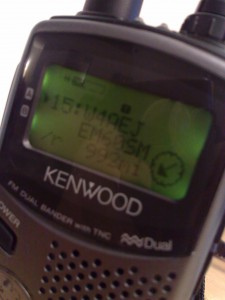00000010 with the International Space Station

APRS Display: W4AEJ, 992 miles away
Friday Nights are typically “Satellite Night” for a few of the Resistors. We get together and aim for the stars (literally) and generally try to communicate with other intrepid radio operators. Last Friday night, atop an ivory tower in the frigid winter wind, we set out to communicate with the International Space Station.
Diana, Dave and I met early in the evening with our homebrew dual-band Yagi antennas, a myriad of handheld radios, and a few satellite pass predictions. Manmade Satellites travel in predictable orbits around the Earth, and sites such as www.heavens-above.com provide pass predictions that make it easy to plan for an evening of satellite chasing.
Typically we try to communicate with other ham radio operators via FM voice using a combination of 2 meter (144-148MHz) and 70 centimeter (420-450MHz) frequencies. We transmit to the satellite on the 2m frequency, and the satellite responds on the 70cm frequency as a repeater – something akin to a mirror which reflects back to you what you’re sending. While the astronauts periodically participate, most of the time the ISS acts as a repeater for ground stations, allowing hams from all over the ISS’s “footprint” of coverage to communicate with one another.
This night was different, however, in that the ISS was also operating a digital radio modem, which permitted amateurs to reflect short messages and GPS position data off the Station. This technique, known as the Automatic Packet Reporting System (APRS) is very popular within the ham community and enables vehicle tracking, sensor data from automated weather stations (and other types of sensors,) and short messages with guaranteed delivery. I happened to have a radio equipped with a 1200/9600 bps modem and an APRS software implementation built into the firmware.
Up on the roof, we struggled to reach the satellite via voice, but the ISS’ modem was clear. I flipped the radio to APRS mode and transmitted 5 watts of RF on the 2 meter band into the copper arrow we made months ago. The satellite was crowded with other operators trying to make contact, but persistence paid off and an echo of my APRS packet flashed on the radio’s tiny screen.
Later, after we’d had enough of the cold wind, we checked the Internet and found the position report. Sure enough, RS0ISS-3, the APRS node on the Station, had received and re-transmitted our position to the Internet gateway. Afterward, we attempted another contact with the SaudiSat SO-50, carrying a voice payload – but were unable to reach it. Perhaps next Friday will bring more successful contacts for the intrepid trio.
The ISS I have tried so many times but I have set sights on a much bigger satellite…did someone say moon bounce?? ;D
What type of radio is that pictured?
TK, it’s an “old” Kenwood TH-D7 dual-band radio. It’s a late 1990’s model, if I recall correctly. Yaesu, another manufacturer, has released one very recently, the VX-8R that incorporates this functionality internally if you’re interested in buying something. It’s also rather small by comparison to this TH-D7.
KD4ISF
Cool beans. Check out some of the recordings I have made on my site linked here. sure its just a bunch of files, actual pages would require motivation for me.